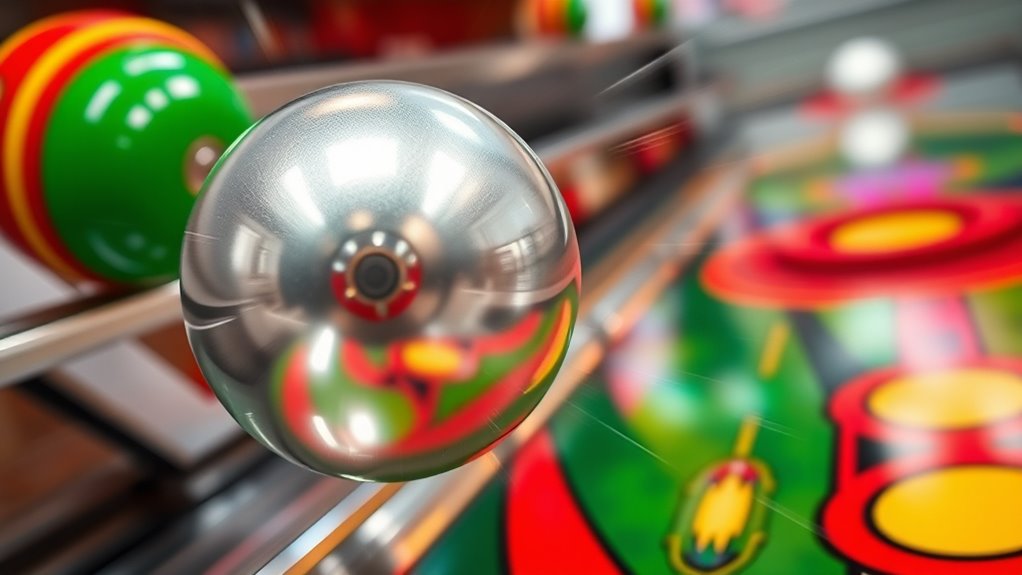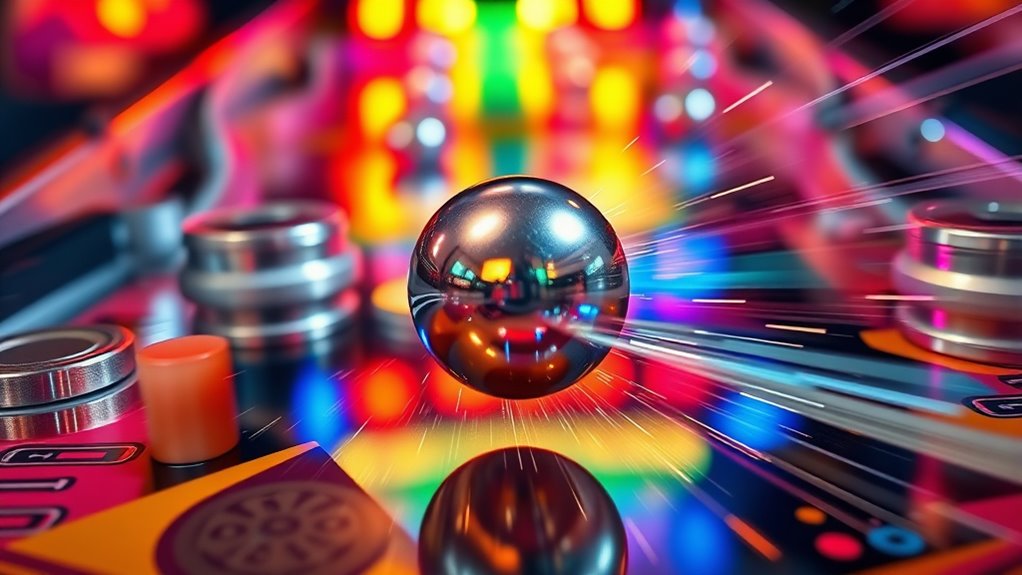In pinball, gravity pulls the ball downward, shaping its arc as you launch and aim. Momentum carries the ball forward after each hit, with speed and impact angle affecting rebounds and target hits. Spin, often caused by flippers, influences how the ball interacts with bumpers and surfaces, changing its bounce and glide. Understanding these physics principles helps you control your shots better. Keep exploring, and you’ll uncover even more ways physics shapes your game.
Key Takeaways
- Gravity influences the ball’s curved trajectory, shaping its arc and interaction with targets and bumpers.
- Launch angle and force determine initial momentum, affecting ball speed and path through the pinball machine.
- Bumper elasticity and impact speed govern energy transfer, causing rebounds and chain reactions that impact gameplay.
- Spin, imparted by flippers or collisions, alters the ball’s interaction with surfaces, affecting bounce and trajectory control.
- Conservation of energy and momentum during collisions ensures realistic ball behavior and strategic shot outcomes.

Pinball machines are a fascinating playground of physics, where your shots are influenced by forces like gravity, momentum, and collision dynamics. When you launch the ball onto the playfield, its initial velocity and angle set the stage for an intricate journey shaped by these physical principles. The ball’s trajectory depends heavily on the angle of launch and the force behind it. As the ball moves across the surface, gravity gradually pulls it downward, curving its path and creating a predictable arc. You can manipulate this trajectory by adjusting your shots, aiming for specific targets or avoiding obstacles. The way the ball responds to each collision is dictated by bumper dynamics, which involve the elasticity and mass of the bumpers, as well as the speed of impact. When the ball hits a bumper, its momentum is transferred, causing it to bounce away with a new trajectory that can be unpredictable yet governed by physical laws. Bumper dynamics are *essential* for understanding how the ball ricochets through the playfield, often leading to exciting chain reactions and score multipliers. Additionally, the material properties of the bumpers influence how energy is conserved during impacts, affecting the overall flow of the game.
Your control over the ball’s path involves understanding how momentum influences its motion. When you hit the ball with the flipper, you impart angular momentum, causing it to spin. This spin affects how the ball interacts with the playfield surfaces and bumpers, altering its trajectory after each collision. A ball with a strong spin might glide along certain paths or bounce differently off surfaces, giving you strategic advantages. The physics of spin and collision are interconnected; a well-timed flip can change the ball’s collision outcome, making it ricochet into more advantageous positions. Understanding bumper dynamics also helps you predict how the ball will behave when it encounters bumpers, ramps, or targets. The elasticity of bumpers determines whether the ball bounces back with the same speed or loses some energy, influencing subsequent trajectories. These interactions make pinball a dynamic game, where physics principles like conservation of momentum and energy come into play, and your skill in reading these cues can turn the tide of the game.
In essence, mastering the physics of pinball involves recognizing how gravity influences the ball’s arc, how bumper dynamics shape its rebounds, and how spin and momentum alter its overall behavior. Every shot you take is a practical application of these principles, turning physics into an engaging challenge. By paying attention to how the ball moves and reacts, you’ll develop better intuition for controlling its trajectory and maximizing your score. Pinball isn’t just a game of luck; it’s a complex dance of physical forces—one that you can learn to control with practice and keen observation. Understanding collision dynamics and how energy is conserved during impacts can significantly improve your gameplay and strategic planning.
Frequently Asked Questions
How Do Different Pinball Machine Designs Affect Ball Physics?
Different pinball machine designs influence ball physics through features like magnetic fields and flipper mechanics. Magnetic fields can alter a ball’s trajectory, making it harder to predict or control its movement. Meanwhile, flipper mechanics determine how forcefully you hit the ball, affecting its speed and spin. These design elements create varied gameplay experiences by modifying how the ball responds to gravity, momentum, and spin, keeping the game challenging and exciting.
Can Players Control Spin and Momentum Intentionally During Gameplay?
Can you truly master ball control and influence momentum during gameplay? Yes, you can intentionally control spin and momentum through precise timing and skillful nudges. Your player influence allows you to manipulate the ball’s spin, affecting its trajectory and bounce. By understanding the physics involved, you enhance your gameplay strategy, making deliberate shots that optimize ball control and increase your chances of hitting targets or triggering bonuses.
How Does Air Resistance Influence Ball Movement on the Playfield?
Air resistance, or air drag, impacts your pinball’s movement by slowing it down as it moves across the playfield. You might notice airflow patterns subtly influencing its trajectory, especially at higher speeds. When the ball encounters areas with different airflow, such as near bumpers or ramps, it can change direction slightly. Understanding these effects helps you predict ball behavior and improve your gameplay strategy.
What Role Does Material Elasticity Play in Ball Rebounds?
Material elasticity determines how well the ball rebounds during an elastic collision. When you hit a bumper or a flipper, the ball’s rebound energy depends on the elasticity of both surfaces. Higher elasticity means less energy is lost, resulting in a stronger rebound. If the materials are less elastic, more energy dissipates as heat or deformation, softening the rebound and affecting your control and game dynamics.
How Do Environmental Factors Like Temperature Impact Pinball Physics?
Imagine the lively clatter of a pinball bouncing unpredictably; now, notice how temperature effects make the ball’s surface slicker or stickier. Higher temperatures can soften the ball and table, reducing bounce, while lower temps stiffen materials, increasing rebound unpredictability. Humidity impact adds a sticky layer, slowing down the ball and altering spin. You’ll see these environmental factors subtly yet markedly influence your game’s physics.
Conclusion
Now that you’ve seen how gravity, momentum, and spin influence every bounce and roll, do you realize how much physics is behind that flashing, bouncing game? Pinball isn’t just luck; it’s a real-world application of complex forces working together. So next time you hit the flipper, remember—you’re playing a mini physics experiment. Isn’t it amazing how understanding these forces can make you a better player and a curious scientist at the same time?








